NEF6001 Research Project: Biometric Smart Home Automation Analysis
VerifiedAdded on 2022/09/17
|8
|2308
|26
Project
AI Summary
This research project explores the application of biometric authentication in smart home automation, aiming to enhance security and control access to residential properties. The project delves into various biometric methods, including fingerprint recognition, facial recognition, voice recognition, and retina scanning, analyzing their strengths, weaknesses, and potential vulnerabilities. The report provides a detailed background on biometric authentication, outlining the advantages of using biometric systems over traditional password-based systems. It also identifies and discusses the research problems associated with biometric authentication, such as the potential for cyberattacks and the replication of biometric data. The research methodology, which employs a qualitative approach based on the grounded theory methodology, is explained, along with the software requirements for each biometric system. The significance of the research lies in its contribution to understanding the effectiveness of biometric authentication for identity verification and its role in securing residential complexes. The project concludes by emphasizing the importance of implementing biometric systems for improved home security, highlighting the suitability of biometric authentication as a superior method compared to existing authentication techniques. The report also includes a comprehensive research plan and a list of references.
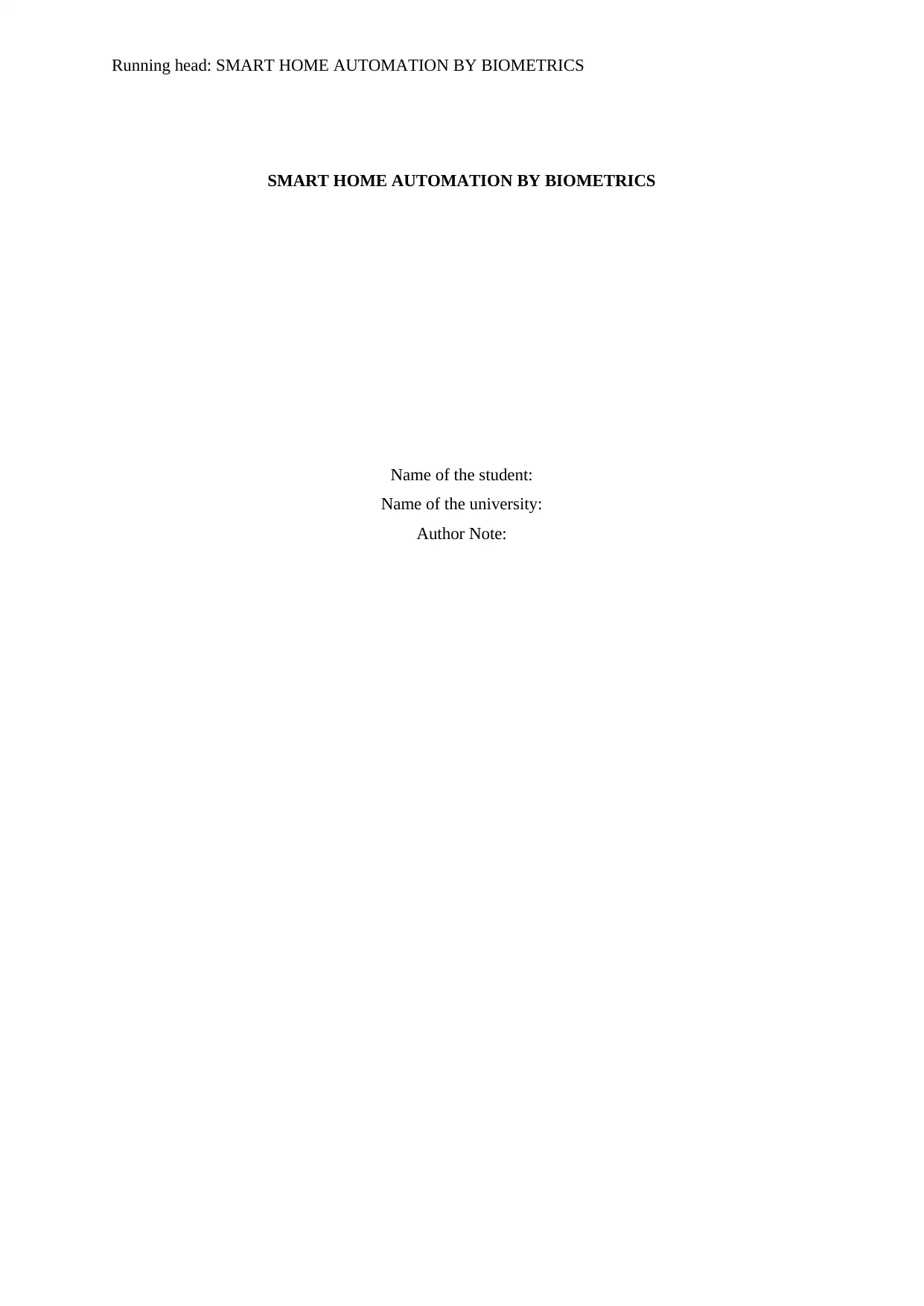
Running head: SMART HOME AUTOMATION BY BIOMETRICS
SMART HOME AUTOMATION BY BIOMETRICS
Name of the student:
Name of the university:
Author Note:
SMART HOME AUTOMATION BY BIOMETRICS
Name of the student:
Name of the university:
Author Note:
Paraphrase This Document
Need a fresh take? Get an instant paraphrase of this document with our AI Paraphraser
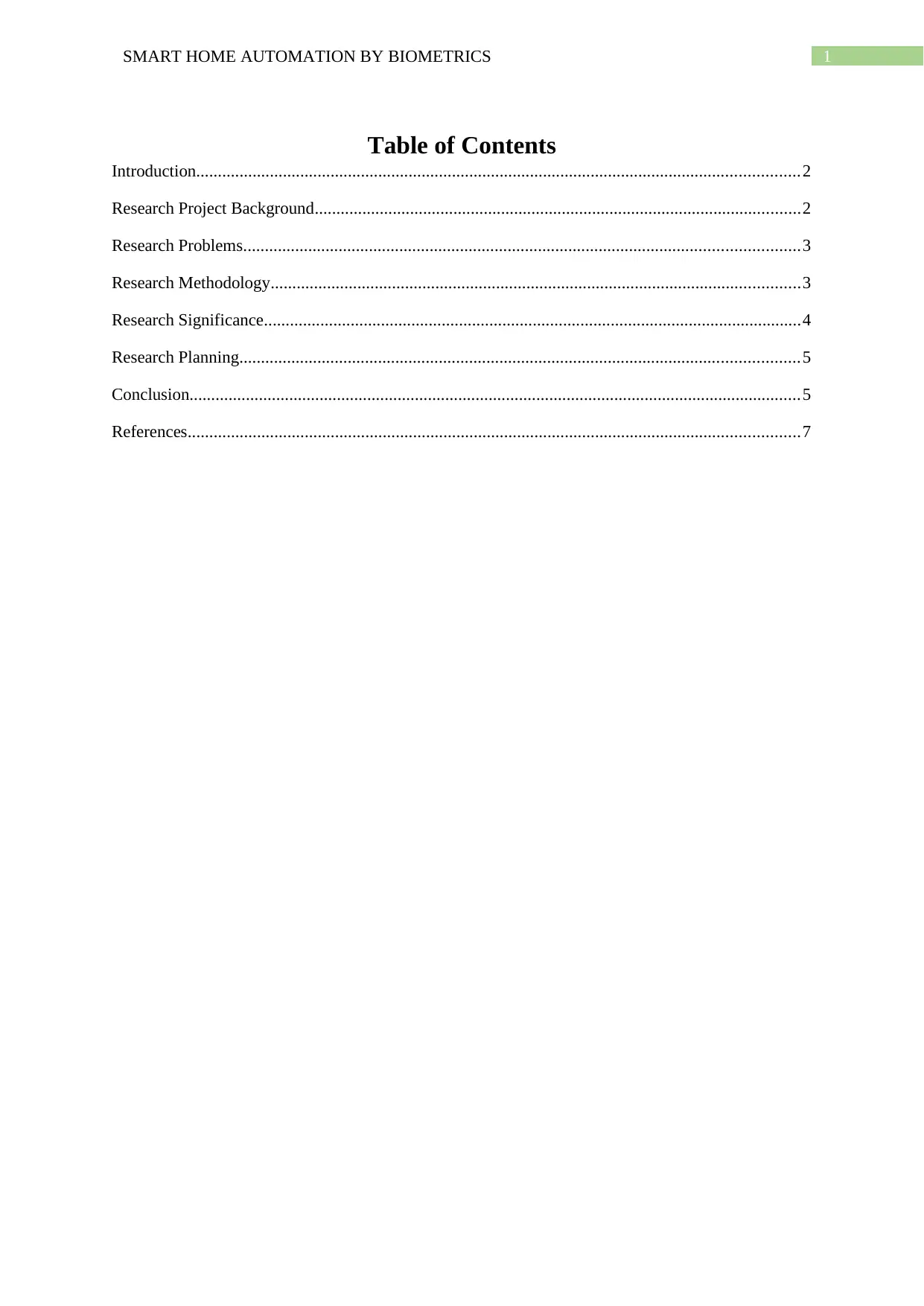
1SMART HOME AUTOMATION BY BIOMETRICS
Table of Contents
Introduction...........................................................................................................................................2
Research Project Background................................................................................................................2
Research Problems................................................................................................................................3
Research Methodology..........................................................................................................................3
Research Significance............................................................................................................................4
Research Planning.................................................................................................................................5
Conclusion.............................................................................................................................................5
References.............................................................................................................................................7
Table of Contents
Introduction...........................................................................................................................................2
Research Project Background................................................................................................................2
Research Problems................................................................................................................................3
Research Methodology..........................................................................................................................3
Research Significance............................................................................................................................4
Research Planning.................................................................................................................................5
Conclusion.............................................................................................................................................5
References.............................................................................................................................................7
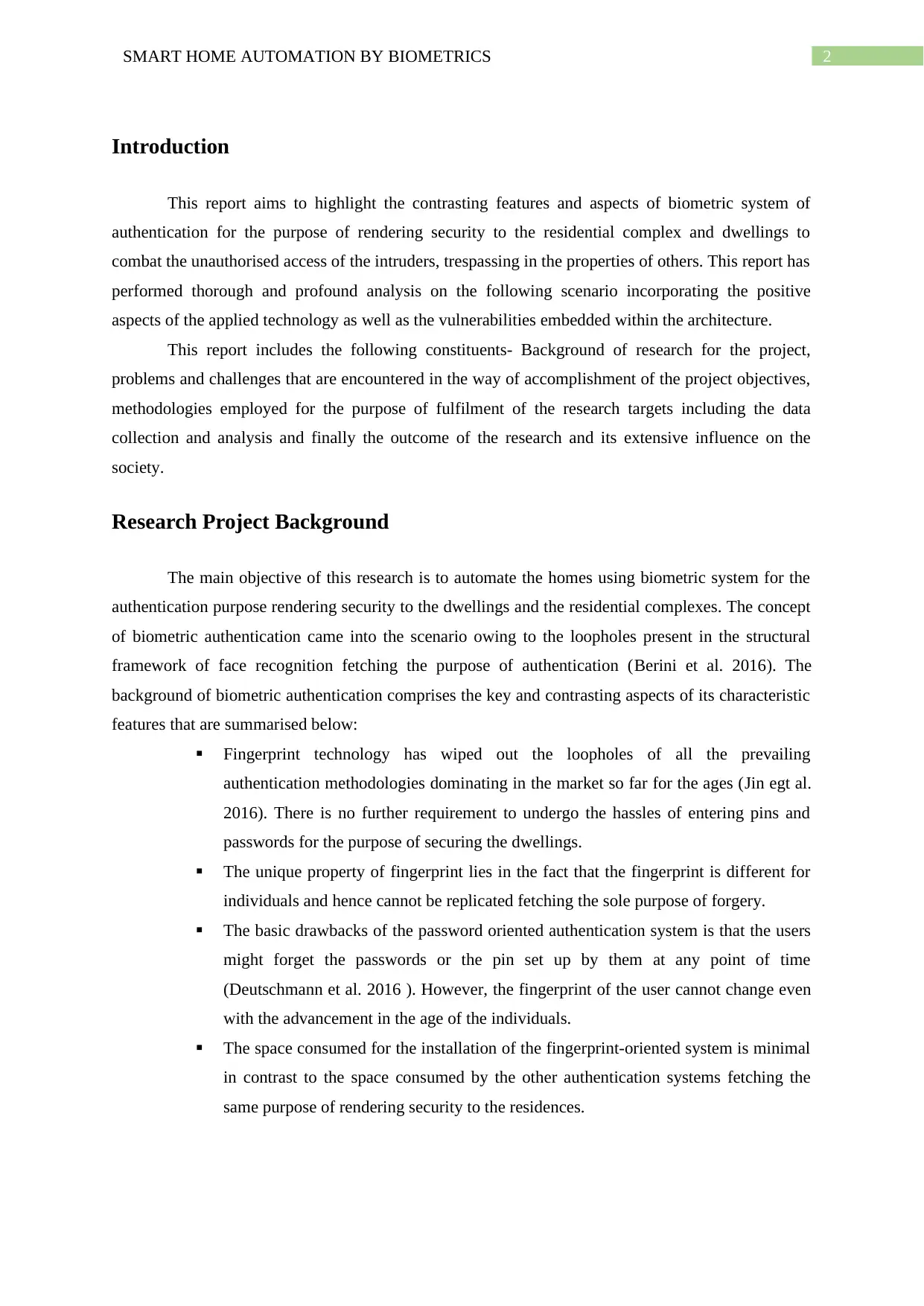
2SMART HOME AUTOMATION BY BIOMETRICS
Introduction
This report aims to highlight the contrasting features and aspects of biometric system of
authentication for the purpose of rendering security to the residential complex and dwellings to
combat the unauthorised access of the intruders, trespassing in the properties of others. This report has
performed thorough and profound analysis on the following scenario incorporating the positive
aspects of the applied technology as well as the vulnerabilities embedded within the architecture.
This report includes the following constituents- Background of research for the project,
problems and challenges that are encountered in the way of accomplishment of the project objectives,
methodologies employed for the purpose of fulfilment of the research targets including the data
collection and analysis and finally the outcome of the research and its extensive influence on the
society.
Research Project Background
The main objective of this research is to automate the homes using biometric system for the
authentication purpose rendering security to the dwellings and the residential complexes. The concept
of biometric authentication came into the scenario owing to the loopholes present in the structural
framework of face recognition fetching the purpose of authentication (Berini et al. 2016). The
background of biometric authentication comprises the key and contrasting aspects of its characteristic
features that are summarised below:
Fingerprint technology has wiped out the loopholes of all the prevailing
authentication methodologies dominating in the market so far for the ages (Jin egt al.
2016). There is no further requirement to undergo the hassles of entering pins and
passwords for the purpose of securing the dwellings.
The unique property of fingerprint lies in the fact that the fingerprint is different for
individuals and hence cannot be replicated fetching the sole purpose of forgery.
The basic drawbacks of the password oriented authentication system is that the users
might forget the passwords or the pin set up by them at any point of time
(Deutschmann et al. 2016 ). However, the fingerprint of the user cannot change even
with the advancement in the age of the individuals.
The space consumed for the installation of the fingerprint-oriented system is minimal
in contrast to the space consumed by the other authentication systems fetching the
same purpose of rendering security to the residences.
Introduction
This report aims to highlight the contrasting features and aspects of biometric system of
authentication for the purpose of rendering security to the residential complex and dwellings to
combat the unauthorised access of the intruders, trespassing in the properties of others. This report has
performed thorough and profound analysis on the following scenario incorporating the positive
aspects of the applied technology as well as the vulnerabilities embedded within the architecture.
This report includes the following constituents- Background of research for the project,
problems and challenges that are encountered in the way of accomplishment of the project objectives,
methodologies employed for the purpose of fulfilment of the research targets including the data
collection and analysis and finally the outcome of the research and its extensive influence on the
society.
Research Project Background
The main objective of this research is to automate the homes using biometric system for the
authentication purpose rendering security to the dwellings and the residential complexes. The concept
of biometric authentication came into the scenario owing to the loopholes present in the structural
framework of face recognition fetching the purpose of authentication (Berini et al. 2016). The
background of biometric authentication comprises the key and contrasting aspects of its characteristic
features that are summarised below:
Fingerprint technology has wiped out the loopholes of all the prevailing
authentication methodologies dominating in the market so far for the ages (Jin egt al.
2016). There is no further requirement to undergo the hassles of entering pins and
passwords for the purpose of securing the dwellings.
The unique property of fingerprint lies in the fact that the fingerprint is different for
individuals and hence cannot be replicated fetching the sole purpose of forgery.
The basic drawbacks of the password oriented authentication system is that the users
might forget the passwords or the pin set up by them at any point of time
(Deutschmann et al. 2016 ). However, the fingerprint of the user cannot change even
with the advancement in the age of the individuals.
The space consumed for the installation of the fingerprint-oriented system is minimal
in contrast to the space consumed by the other authentication systems fetching the
same purpose of rendering security to the residences.
⊘ This is a preview!⊘
Do you want full access?
Subscribe today to unlock all pages.

Trusted by 1+ million students worldwide
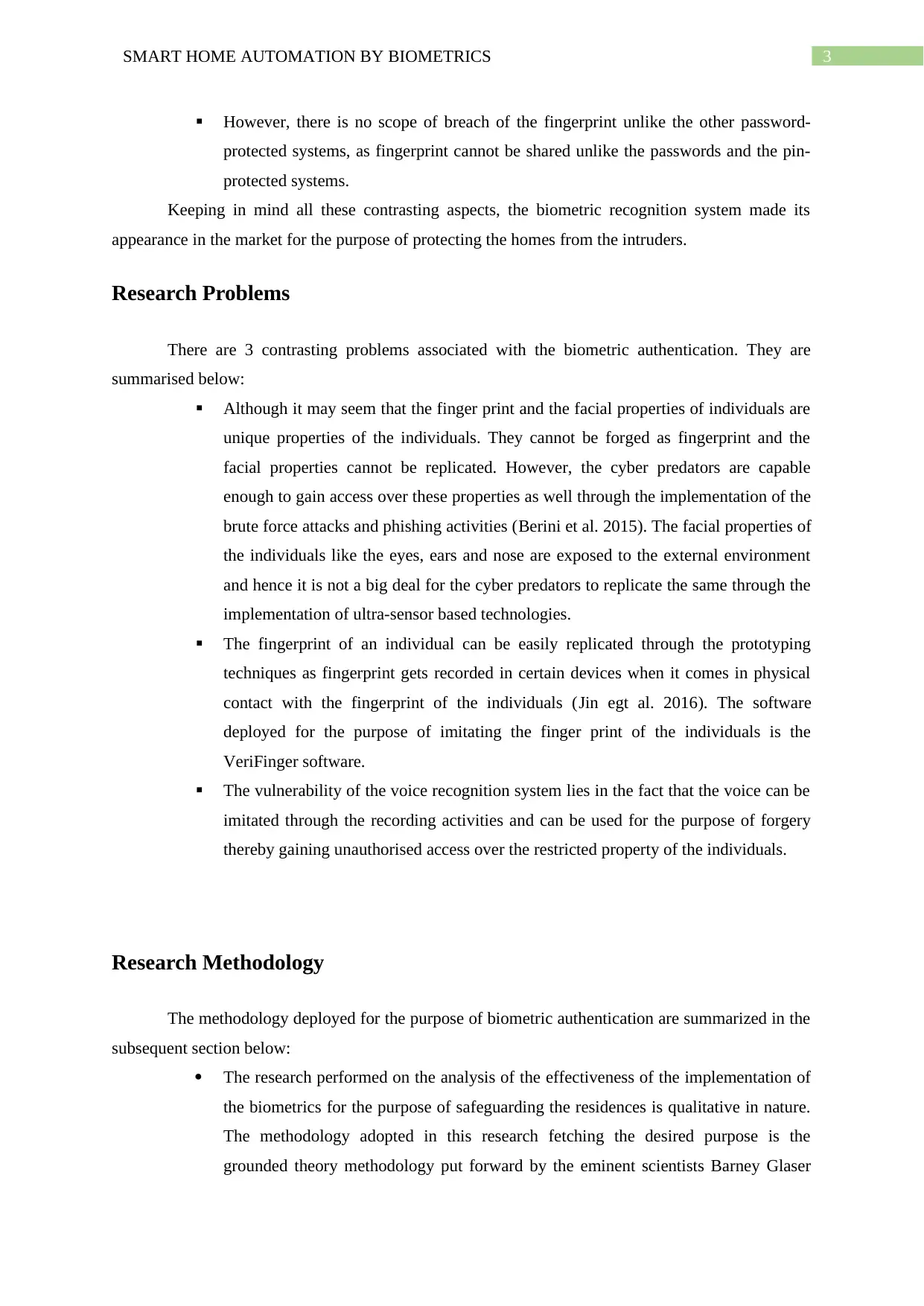
3SMART HOME AUTOMATION BY BIOMETRICS
However, there is no scope of breach of the fingerprint unlike the other password-
protected systems, as fingerprint cannot be shared unlike the passwords and the pin-
protected systems.
Keeping in mind all these contrasting aspects, the biometric recognition system made its
appearance in the market for the purpose of protecting the homes from the intruders.
Research Problems
There are 3 contrasting problems associated with the biometric authentication. They are
summarised below:
Although it may seem that the finger print and the facial properties of individuals are
unique properties of the individuals. They cannot be forged as fingerprint and the
facial properties cannot be replicated. However, the cyber predators are capable
enough to gain access over these properties as well through the implementation of the
brute force attacks and phishing activities (Berini et al. 2015). The facial properties of
the individuals like the eyes, ears and nose are exposed to the external environment
and hence it is not a big deal for the cyber predators to replicate the same through the
implementation of ultra-sensor based technologies.
The fingerprint of an individual can be easily replicated through the prototyping
techniques as fingerprint gets recorded in certain devices when it comes in physical
contact with the fingerprint of the individuals (Jin egt al. 2016). The software
deployed for the purpose of imitating the finger print of the individuals is the
VeriFinger software.
The vulnerability of the voice recognition system lies in the fact that the voice can be
imitated through the recording activities and can be used for the purpose of forgery
thereby gaining unauthorised access over the restricted property of the individuals.
Research Methodology
The methodology deployed for the purpose of biometric authentication are summarized in the
subsequent section below:
The research performed on the analysis of the effectiveness of the implementation of
the biometrics for the purpose of safeguarding the residences is qualitative in nature.
The methodology adopted in this research fetching the desired purpose is the
grounded theory methodology put forward by the eminent scientists Barney Glaser
However, there is no scope of breach of the fingerprint unlike the other password-
protected systems, as fingerprint cannot be shared unlike the passwords and the pin-
protected systems.
Keeping in mind all these contrasting aspects, the biometric recognition system made its
appearance in the market for the purpose of protecting the homes from the intruders.
Research Problems
There are 3 contrasting problems associated with the biometric authentication. They are
summarised below:
Although it may seem that the finger print and the facial properties of individuals are
unique properties of the individuals. They cannot be forged as fingerprint and the
facial properties cannot be replicated. However, the cyber predators are capable
enough to gain access over these properties as well through the implementation of the
brute force attacks and phishing activities (Berini et al. 2015). The facial properties of
the individuals like the eyes, ears and nose are exposed to the external environment
and hence it is not a big deal for the cyber predators to replicate the same through the
implementation of ultra-sensor based technologies.
The fingerprint of an individual can be easily replicated through the prototyping
techniques as fingerprint gets recorded in certain devices when it comes in physical
contact with the fingerprint of the individuals (Jin egt al. 2016). The software
deployed for the purpose of imitating the finger print of the individuals is the
VeriFinger software.
The vulnerability of the voice recognition system lies in the fact that the voice can be
imitated through the recording activities and can be used for the purpose of forgery
thereby gaining unauthorised access over the restricted property of the individuals.
Research Methodology
The methodology deployed for the purpose of biometric authentication are summarized in the
subsequent section below:
The research performed on the analysis of the effectiveness of the implementation of
the biometrics for the purpose of safeguarding the residences is qualitative in nature.
The methodology adopted in this research fetching the desired purpose is the
grounded theory methodology put forward by the eminent scientists Barney Glaser
Paraphrase This Document
Need a fresh take? Get an instant paraphrase of this document with our AI Paraphraser
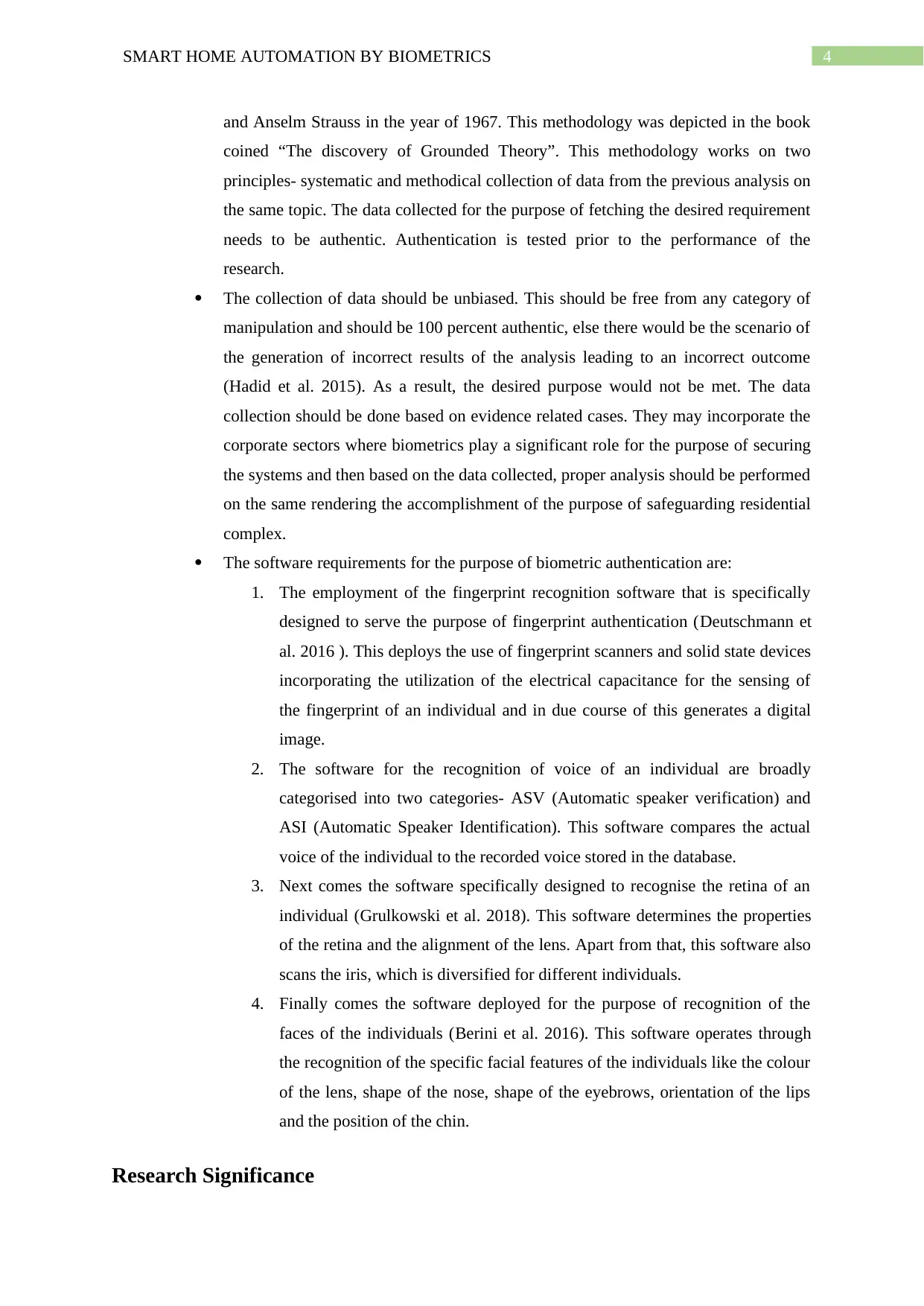
4SMART HOME AUTOMATION BY BIOMETRICS
and Anselm Strauss in the year of 1967. This methodology was depicted in the book
coined “The discovery of Grounded Theory”. This methodology works on two
principles- systematic and methodical collection of data from the previous analysis on
the same topic. The data collected for the purpose of fetching the desired requirement
needs to be authentic. Authentication is tested prior to the performance of the
research.
The collection of data should be unbiased. This should be free from any category of
manipulation and should be 100 percent authentic, else there would be the scenario of
the generation of incorrect results of the analysis leading to an incorrect outcome
(Hadid et al. 2015). As a result, the desired purpose would not be met. The data
collection should be done based on evidence related cases. They may incorporate the
corporate sectors where biometrics play a significant role for the purpose of securing
the systems and then based on the data collected, proper analysis should be performed
on the same rendering the accomplishment of the purpose of safeguarding residential
complex.
The software requirements for the purpose of biometric authentication are:
1. The employment of the fingerprint recognition software that is specifically
designed to serve the purpose of fingerprint authentication (Deutschmann et
al. 2016 ). This deploys the use of fingerprint scanners and solid state devices
incorporating the utilization of the electrical capacitance for the sensing of
the fingerprint of an individual and in due course of this generates a digital
image.
2. The software for the recognition of voice of an individual are broadly
categorised into two categories- ASV (Automatic speaker verification) and
ASI (Automatic Speaker Identification). This software compares the actual
voice of the individual to the recorded voice stored in the database.
3. Next comes the software specifically designed to recognise the retina of an
individual (Grulkowski et al. 2018). This software determines the properties
of the retina and the alignment of the lens. Apart from that, this software also
scans the iris, which is diversified for different individuals.
4. Finally comes the software deployed for the purpose of recognition of the
faces of the individuals (Berini et al. 2016). This software operates through
the recognition of the specific facial features of the individuals like the colour
of the lens, shape of the nose, shape of the eyebrows, orientation of the lips
and the position of the chin.
Research Significance
and Anselm Strauss in the year of 1967. This methodology was depicted in the book
coined “The discovery of Grounded Theory”. This methodology works on two
principles- systematic and methodical collection of data from the previous analysis on
the same topic. The data collected for the purpose of fetching the desired requirement
needs to be authentic. Authentication is tested prior to the performance of the
research.
The collection of data should be unbiased. This should be free from any category of
manipulation and should be 100 percent authentic, else there would be the scenario of
the generation of incorrect results of the analysis leading to an incorrect outcome
(Hadid et al. 2015). As a result, the desired purpose would not be met. The data
collection should be done based on evidence related cases. They may incorporate the
corporate sectors where biometrics play a significant role for the purpose of securing
the systems and then based on the data collected, proper analysis should be performed
on the same rendering the accomplishment of the purpose of safeguarding residential
complex.
The software requirements for the purpose of biometric authentication are:
1. The employment of the fingerprint recognition software that is specifically
designed to serve the purpose of fingerprint authentication (Deutschmann et
al. 2016 ). This deploys the use of fingerprint scanners and solid state devices
incorporating the utilization of the electrical capacitance for the sensing of
the fingerprint of an individual and in due course of this generates a digital
image.
2. The software for the recognition of voice of an individual are broadly
categorised into two categories- ASV (Automatic speaker verification) and
ASI (Automatic Speaker Identification). This software compares the actual
voice of the individual to the recorded voice stored in the database.
3. Next comes the software specifically designed to recognise the retina of an
individual (Grulkowski et al. 2018). This software determines the properties
of the retina and the alignment of the lens. Apart from that, this software also
scans the iris, which is diversified for different individuals.
4. Finally comes the software deployed for the purpose of recognition of the
faces of the individuals (Berini et al. 2016). This software operates through
the recognition of the specific facial features of the individuals like the colour
of the lens, shape of the nose, shape of the eyebrows, orientation of the lips
and the position of the chin.
Research Significance
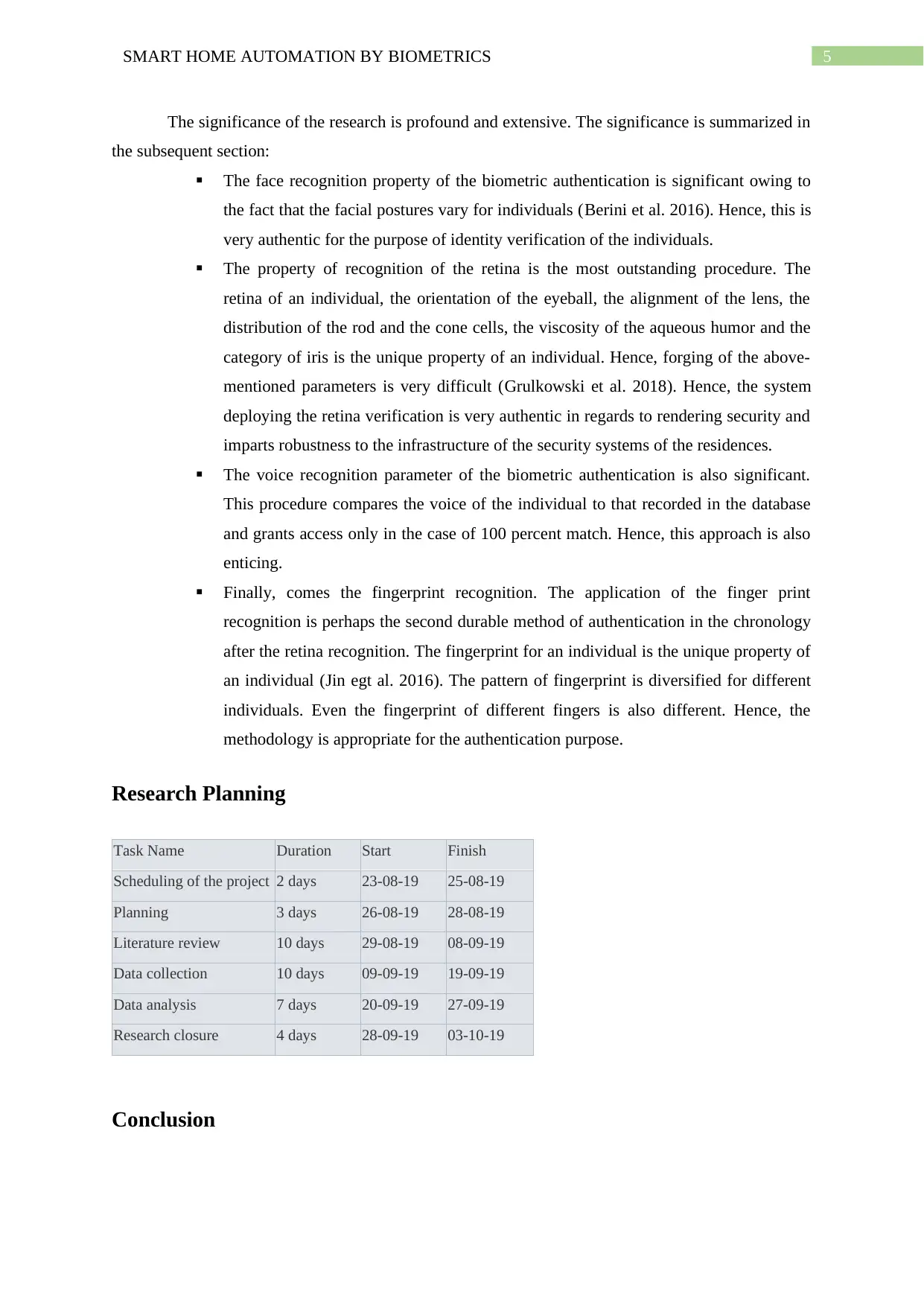
5SMART HOME AUTOMATION BY BIOMETRICS
The significance of the research is profound and extensive. The significance is summarized in
the subsequent section:
The face recognition property of the biometric authentication is significant owing to
the fact that the facial postures vary for individuals (Berini et al. 2016). Hence, this is
very authentic for the purpose of identity verification of the individuals.
The property of recognition of the retina is the most outstanding procedure. The
retina of an individual, the orientation of the eyeball, the alignment of the lens, the
distribution of the rod and the cone cells, the viscosity of the aqueous humor and the
category of iris is the unique property of an individual. Hence, forging of the above-
mentioned parameters is very difficult (Grulkowski et al. 2018). Hence, the system
deploying the retina verification is very authentic in regards to rendering security and
imparts robustness to the infrastructure of the security systems of the residences.
The voice recognition parameter of the biometric authentication is also significant.
This procedure compares the voice of the individual to that recorded in the database
and grants access only in the case of 100 percent match. Hence, this approach is also
enticing.
Finally, comes the fingerprint recognition. The application of the finger print
recognition is perhaps the second durable method of authentication in the chronology
after the retina recognition. The fingerprint for an individual is the unique property of
an individual (Jin egt al. 2016). The pattern of fingerprint is diversified for different
individuals. Even the fingerprint of different fingers is also different. Hence, the
methodology is appropriate for the authentication purpose.
Research Planning
Task Name Duration Start Finish
Scheduling of the project 2 days 23-08-19 25-08-19
Planning 3 days 26-08-19 28-08-19
Literature review 10 days 29-08-19 08-09-19
Data collection 10 days 09-09-19 19-09-19
Data analysis 7 days 20-09-19 27-09-19
Research closure 4 days 28-09-19 03-10-19
Conclusion
The significance of the research is profound and extensive. The significance is summarized in
the subsequent section:
The face recognition property of the biometric authentication is significant owing to
the fact that the facial postures vary for individuals (Berini et al. 2016). Hence, this is
very authentic for the purpose of identity verification of the individuals.
The property of recognition of the retina is the most outstanding procedure. The
retina of an individual, the orientation of the eyeball, the alignment of the lens, the
distribution of the rod and the cone cells, the viscosity of the aqueous humor and the
category of iris is the unique property of an individual. Hence, forging of the above-
mentioned parameters is very difficult (Grulkowski et al. 2018). Hence, the system
deploying the retina verification is very authentic in regards to rendering security and
imparts robustness to the infrastructure of the security systems of the residences.
The voice recognition parameter of the biometric authentication is also significant.
This procedure compares the voice of the individual to that recorded in the database
and grants access only in the case of 100 percent match. Hence, this approach is also
enticing.
Finally, comes the fingerprint recognition. The application of the finger print
recognition is perhaps the second durable method of authentication in the chronology
after the retina recognition. The fingerprint for an individual is the unique property of
an individual (Jin egt al. 2016). The pattern of fingerprint is diversified for different
individuals. Even the fingerprint of different fingers is also different. Hence, the
methodology is appropriate for the authentication purpose.
Research Planning
Task Name Duration Start Finish
Scheduling of the project 2 days 23-08-19 25-08-19
Planning 3 days 26-08-19 28-08-19
Literature review 10 days 29-08-19 08-09-19
Data collection 10 days 09-09-19 19-09-19
Data analysis 7 days 20-09-19 27-09-19
Research closure 4 days 28-09-19 03-10-19
Conclusion
⊘ This is a preview!⊘
Do you want full access?
Subscribe today to unlock all pages.

Trusted by 1+ million students worldwide
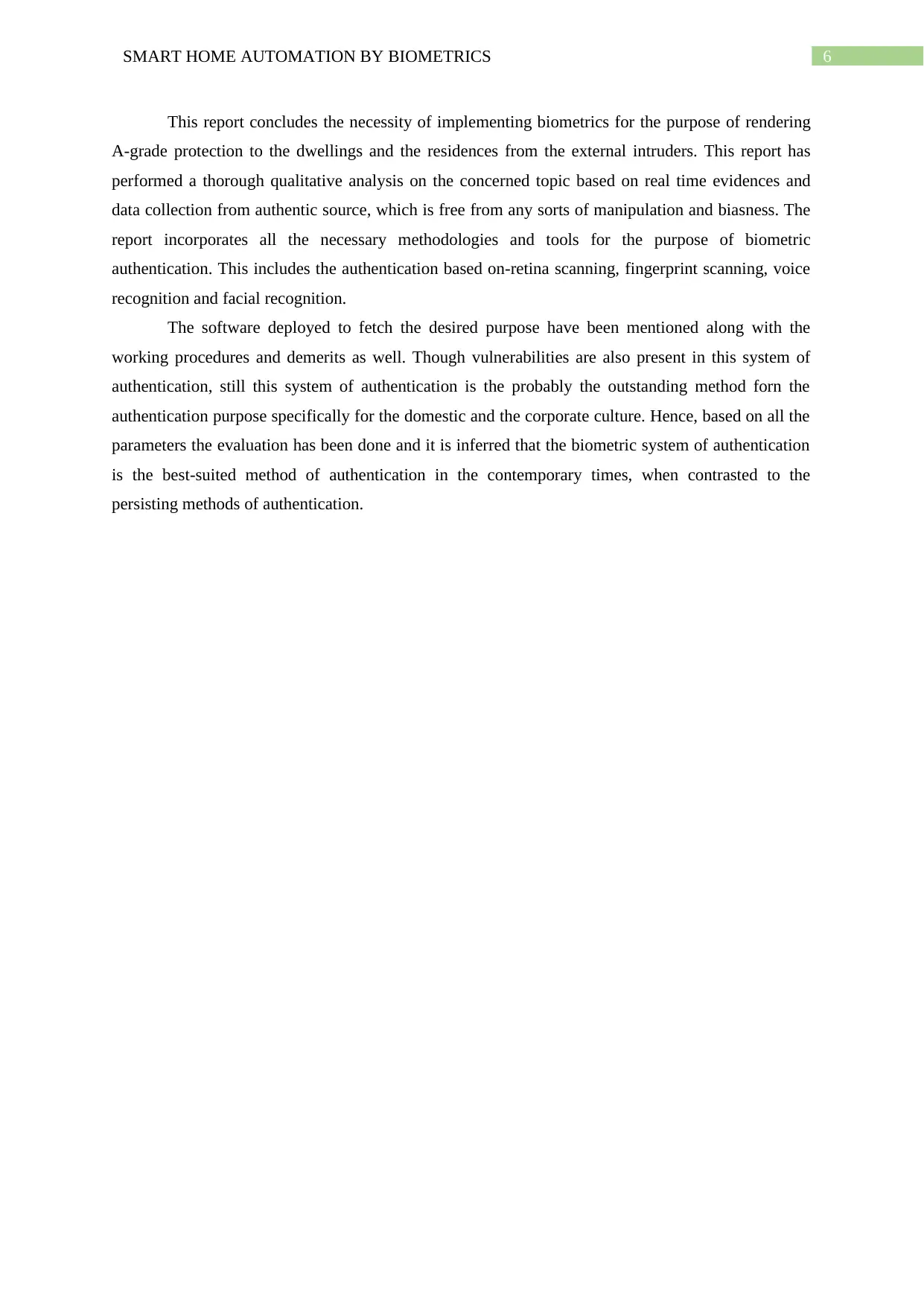
6SMART HOME AUTOMATION BY BIOMETRICS
This report concludes the necessity of implementing biometrics for the purpose of rendering
A-grade protection to the dwellings and the residences from the external intruders. This report has
performed a thorough qualitative analysis on the concerned topic based on real time evidences and
data collection from authentic source, which is free from any sorts of manipulation and biasness. The
report incorporates all the necessary methodologies and tools for the purpose of biometric
authentication. This includes the authentication based on-retina scanning, fingerprint scanning, voice
recognition and facial recognition.
The software deployed to fetch the desired purpose have been mentioned along with the
working procedures and demerits as well. Though vulnerabilities are also present in this system of
authentication, still this system of authentication is the probably the outstanding method forn the
authentication purpose specifically for the domestic and the corporate culture. Hence, based on all the
parameters the evaluation has been done and it is inferred that the biometric system of authentication
is the best-suited method of authentication in the contemporary times, when contrasted to the
persisting methods of authentication.
This report concludes the necessity of implementing biometrics for the purpose of rendering
A-grade protection to the dwellings and the residences from the external intruders. This report has
performed a thorough qualitative analysis on the concerned topic based on real time evidences and
data collection from authentic source, which is free from any sorts of manipulation and biasness. The
report incorporates all the necessary methodologies and tools for the purpose of biometric
authentication. This includes the authentication based on-retina scanning, fingerprint scanning, voice
recognition and facial recognition.
The software deployed to fetch the desired purpose have been mentioned along with the
working procedures and demerits as well. Though vulnerabilities are also present in this system of
authentication, still this system of authentication is the probably the outstanding method forn the
authentication purpose specifically for the domestic and the corporate culture. Hence, based on all the
parameters the evaluation has been done and it is inferred that the biometric system of authentication
is the best-suited method of authentication in the contemporary times, when contrasted to the
persisting methods of authentication.
Paraphrase This Document
Need a fresh take? Get an instant paraphrase of this document with our AI Paraphraser
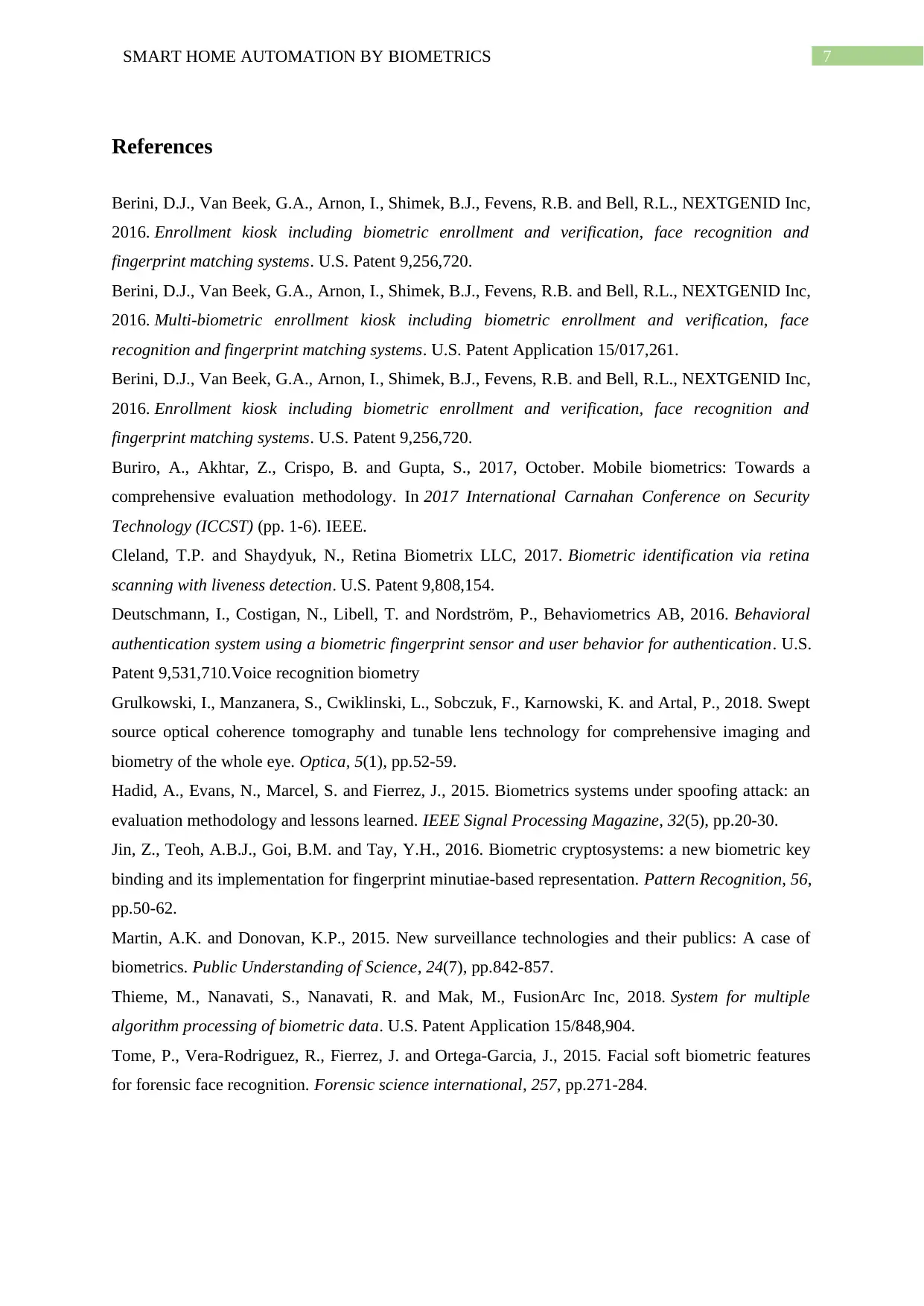
7SMART HOME AUTOMATION BY BIOMETRICS
References
Berini, D.J., Van Beek, G.A., Arnon, I., Shimek, B.J., Fevens, R.B. and Bell, R.L., NEXTGENID Inc,
2016. Enrollment kiosk including biometric enrollment and verification, face recognition and
fingerprint matching systems. U.S. Patent 9,256,720.
Berini, D.J., Van Beek, G.A., Arnon, I., Shimek, B.J., Fevens, R.B. and Bell, R.L., NEXTGENID Inc,
2016. Multi-biometric enrollment kiosk including biometric enrollment and verification, face
recognition and fingerprint matching systems. U.S. Patent Application 15/017,261.
Berini, D.J., Van Beek, G.A., Arnon, I., Shimek, B.J., Fevens, R.B. and Bell, R.L., NEXTGENID Inc,
2016. Enrollment kiosk including biometric enrollment and verification, face recognition and
fingerprint matching systems. U.S. Patent 9,256,720.
Buriro, A., Akhtar, Z., Crispo, B. and Gupta, S., 2017, October. Mobile biometrics: Towards a
comprehensive evaluation methodology. In 2017 International Carnahan Conference on Security
Technology (ICCST) (pp. 1-6). IEEE.
Cleland, T.P. and Shaydyuk, N., Retina Biometrix LLC, 2017. Biometric identification via retina
scanning with liveness detection. U.S. Patent 9,808,154.
Deutschmann, I., Costigan, N., Libell, T. and Nordström, P., Behaviometrics AB, 2016. Behavioral
authentication system using a biometric fingerprint sensor and user behavior for authentication. U.S.
Patent 9,531,710.Voice recognition biometry
Grulkowski, I., Manzanera, S., Cwiklinski, L., Sobczuk, F., Karnowski, K. and Artal, P., 2018. Swept
source optical coherence tomography and tunable lens technology for comprehensive imaging and
biometry of the whole eye. Optica, 5(1), pp.52-59.
Hadid, A., Evans, N., Marcel, S. and Fierrez, J., 2015. Biometrics systems under spoofing attack: an
evaluation methodology and lessons learned. IEEE Signal Processing Magazine, 32(5), pp.20-30.
Jin, Z., Teoh, A.B.J., Goi, B.M. and Tay, Y.H., 2016. Biometric cryptosystems: a new biometric key
binding and its implementation for fingerprint minutiae-based representation. Pattern Recognition, 56,
pp.50-62.
Martin, A.K. and Donovan, K.P., 2015. New surveillance technologies and their publics: A case of
biometrics. Public Understanding of Science, 24(7), pp.842-857.
Thieme, M., Nanavati, S., Nanavati, R. and Mak, M., FusionArc Inc, 2018. System for multiple
algorithm processing of biometric data. U.S. Patent Application 15/848,904.
Tome, P., Vera-Rodriguez, R., Fierrez, J. and Ortega-Garcia, J., 2015. Facial soft biometric features
for forensic face recognition. Forensic science international, 257, pp.271-284.
References
Berini, D.J., Van Beek, G.A., Arnon, I., Shimek, B.J., Fevens, R.B. and Bell, R.L., NEXTGENID Inc,
2016. Enrollment kiosk including biometric enrollment and verification, face recognition and
fingerprint matching systems. U.S. Patent 9,256,720.
Berini, D.J., Van Beek, G.A., Arnon, I., Shimek, B.J., Fevens, R.B. and Bell, R.L., NEXTGENID Inc,
2016. Multi-biometric enrollment kiosk including biometric enrollment and verification, face
recognition and fingerprint matching systems. U.S. Patent Application 15/017,261.
Berini, D.J., Van Beek, G.A., Arnon, I., Shimek, B.J., Fevens, R.B. and Bell, R.L., NEXTGENID Inc,
2016. Enrollment kiosk including biometric enrollment and verification, face recognition and
fingerprint matching systems. U.S. Patent 9,256,720.
Buriro, A., Akhtar, Z., Crispo, B. and Gupta, S., 2017, October. Mobile biometrics: Towards a
comprehensive evaluation methodology. In 2017 International Carnahan Conference on Security
Technology (ICCST) (pp. 1-6). IEEE.
Cleland, T.P. and Shaydyuk, N., Retina Biometrix LLC, 2017. Biometric identification via retina
scanning with liveness detection. U.S. Patent 9,808,154.
Deutschmann, I., Costigan, N., Libell, T. and Nordström, P., Behaviometrics AB, 2016. Behavioral
authentication system using a biometric fingerprint sensor and user behavior for authentication. U.S.
Patent 9,531,710.Voice recognition biometry
Grulkowski, I., Manzanera, S., Cwiklinski, L., Sobczuk, F., Karnowski, K. and Artal, P., 2018. Swept
source optical coherence tomography and tunable lens technology for comprehensive imaging and
biometry of the whole eye. Optica, 5(1), pp.52-59.
Hadid, A., Evans, N., Marcel, S. and Fierrez, J., 2015. Biometrics systems under spoofing attack: an
evaluation methodology and lessons learned. IEEE Signal Processing Magazine, 32(5), pp.20-30.
Jin, Z., Teoh, A.B.J., Goi, B.M. and Tay, Y.H., 2016. Biometric cryptosystems: a new biometric key
binding and its implementation for fingerprint minutiae-based representation. Pattern Recognition, 56,
pp.50-62.
Martin, A.K. and Donovan, K.P., 2015. New surveillance technologies and their publics: A case of
biometrics. Public Understanding of Science, 24(7), pp.842-857.
Thieme, M., Nanavati, S., Nanavati, R. and Mak, M., FusionArc Inc, 2018. System for multiple
algorithm processing of biometric data. U.S. Patent Application 15/848,904.
Tome, P., Vera-Rodriguez, R., Fierrez, J. and Ortega-Garcia, J., 2015. Facial soft biometric features
for forensic face recognition. Forensic science international, 257, pp.271-284.
1 out of 8
Related Documents
Your All-in-One AI-Powered Toolkit for Academic Success.
+13062052269
info@desklib.com
Available 24*7 on WhatsApp / Email
![[object Object]](/_next/static/media/star-bottom.7253800d.svg)
Unlock your academic potential
Copyright © 2020–2025 A2Z Services. All Rights Reserved. Developed and managed by ZUCOL.




